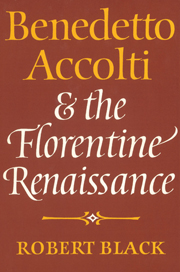Book contents
- Frontmatter
- Contents
- Dedication
- Preface
- Abbreviations
- 1 Arezzo in the early Renaissance
- 2 The Accolti family
- 3 Benedetto Accolti's early life and works
- 4 Accolti in Florence and Arezzo in the 1440s and early 1450s
- 5 Accolti's election as chancellor of Florence
- 6 The Florentine chancellorship
- 7 The Florentine chancery under Accolti
- 8 Accolti's Dialogus
- 9 Accolti's history of the first crusade and the Turkish menace
- 10 Accolti and Renaissance historiography
- Epilogue
- Appendix I Letters of Benedetto Accolti
- Appendix II Accolti's work as a palace official during his chancellorship
- Appendix III Pratica concerned with increasing Accolti's salary as chancellor
- Appendix IV Accolti and the incident of Ponzano, July–August 1463
- Select bibliography
- Index
7 - The Florentine chancery under Accolti
Published online by Cambridge University Press: 12 October 2009
- Frontmatter
- Contents
- Dedication
- Preface
- Abbreviations
- 1 Arezzo in the early Renaissance
- 2 The Accolti family
- 3 Benedetto Accolti's early life and works
- 4 Accolti in Florence and Arezzo in the 1440s and early 1450s
- 5 Accolti's election as chancellor of Florence
- 6 The Florentine chancellorship
- 7 The Florentine chancery under Accolti
- 8 Accolti's Dialogus
- 9 Accolti's history of the first crusade and the Turkish menace
- 10 Accolti and Renaissance historiography
- Epilogue
- Appendix I Letters of Benedetto Accolti
- Appendix II Accolti's work as a palace official during his chancellorship
- Appendix III Pratica concerned with increasing Accolti's salary as chancellor
- Appendix IV Accolti and the incident of Ponzano, July–August 1463
- Select bibliography
- Index
Summary
In view of Accolti's growing dislike of legal practice, it is not surprising that, immediately after his election, he threw himself entirely into the work of the chancery; it has been seen that the Florentine chancellorship was essentially the office of a professional humanist and so in his work as chancellor Accolti was finally able to devote himself to the field of study and activity for which he had hitherto been able to find little time because of the demands of his legal career. After Poggio's disastrous term of office and the interregnum between September 1456 and April 1458, the chancery was in dire need of an effective head, and Accolti was to prove himself more than able to meet the challenge. In his work of renewal and reform, Accolti had two eminently successful predecessors upon whom he could model himself. Indeed, both Leonardo Bruni and Carlo Marsuppini had been not only his compatriots from Arezzo but also his personal friends and mentors, which made it almost inevitable that Accolti would attempt to carry on the methods and practices which they had established in the chancery. In fact, the striking similarities between Accolti's reforms and those introduced by Bruni and Marsuppini suggest that Accolti not only looked to them as models but also had an ambition to join them in the annals of Florentine history, so creating a third Aretine crown among fifteenth-century chancellors to match the three crowns of fourteenth-century Florence, Dante, Petrarch and Boccaccio.
Bruni's ideal of a specialized chancery, it has been seen, had never been realized in his lifetime; only his friend and fellow Aretine, Marsuppini, had achieved an effective separation in the first years of his chancellorship.
- Type
- Chapter
- Information
- Benedetto Accolti and the Florentine Renaissance , pp. 138 - 183Publisher: Cambridge University PressPrint publication year: 1985



